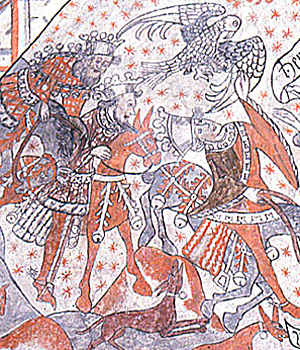| Krisetider

| | Den tidlige middelalders vækst og ekspansion ophører henimod år 1300.
Misvækst, klimaforandring og økologisk krise kulminerer med politiske kriser og Den sorte Døds hærgen i tiden omkring 1350.
Både kongemagten og kirken bygger omfattende borganlæg som værn mod ydre fjender, men også i tilfælde af indbyrdes konflikter. |
Krisens karakter
Den vækst- og ekspansionsperiode der prægede den tidlige middelalder ophører i tiden omkring 1250. Efter en lang periode med nyopdyrkning af jord og udflytning fra de etablerede landsbyer har der antageligt ikke længere været mulighed for at opdyrke og kultivere nye jorder og i 1300-tallet er der ligeledes tydelige tegn på overudnyttelse af ressourcerne. Ekspansionen har medført fældning af store skovområder og anvendelsen af store mængder træ til bygninger, indhegning af dyrkede områder og markskel har betydet rovdrift på skoven og problemer med sandflugt rundt omkring i landet.
Det er vanskeligt at give en udtømmende forklaring på omslaget, men formodentlig har ekspansionen nået en vis naturlig grænse og man konstaterer også et fald i befolkningstallet. En generel økologisk krise kombineret med år med misvækst og klimaforandring i form af temperatur falder det generelle billede, der tegner sig. Hertil kommer så endelig sygdomsepidemier, kulminerende med Den Sorte Død i sidste halvdel af 1300-tallet, hvor anslået 25 % af befolkningen omkommer.
Den politiske krise
Krisen medfører et fald i befolkningstallet, betydelige forandringer i befolkningens sammensætning og status og også ændringer i de politiske magtforhold. Kongen er fortsat rigets overhoved, men hans magtudøvelse finder efterhånden sted i samråd med en aristokratisk klasse af herremænd, som udgør samfundets krigerkaste. Herremændene er blevet styrket i en proces, hvor fyrstelenene bliver arvelige og krigstjenesten begrænses. F.eks. erstattes 1313 det kongelige ledingsudbud i Slesvig af hertugens pligt til at stille med 50 ryttere i krigstid.
Bispelenene stræber også efter øget suverænitet og selvbestemmelse og det giver anledning til konflikter imellem kongemagten og ærkebiskopperne Jacob Erlandsen(død 1274), der vælges udenom kongen i 1252, og senere Jens Grand(valgt 1289). Disse konflikter fører til at riget pålægges interdikt ikke mindre end tre gange. Det er dog tvivlsomt om pavens forbud mod at forrette de kirkelige handlinger har haft nogen reel virkning.
Borgbyggeri
Et synligt vidnesbyrd om de urolige og omskiftelige tider omkring år 1300 var kronens anlæggelse og fornyelse af en række borganlæg rundt omkring i regionen.
Ved Helsingborg afløstes det oprindelige cirkulære tårn med det firkantede og 30 meter høje Kärnan. Denne tårnbygning blev en massiv og sværindtagelig borg. Den nederste del af tårnet var således over 4 meter tyk. Et forsvarsanlæg der kunne stå mål mod tidens selv stærkeste våben. Arbejdet blev iværksat omkring 1310, i Erik Menveds tid, hvor også Falsterbohus og Lindholm længere sydpå i Skåne blev udbygget og forstærket. Falsterbohus fik også et kvadratisk kernetårn og det samme var tilfældet med Lindholmes borg ved Börringesjön i det sydlige Skåne. Falsterbohus overtog efterhånden Skanørborgens opgaver og Helsingborg, med det nye Kärnan, udviklede sig til at blive kronens vigtigste forsvarsværk i Skåne.
På Bornholm udvikles Hammershus efterhånden til det største borganlæg i Norden. I Vordingborg på Sydsjælland opføres et borgkompleks til forsvar af landets sydgrænse og i Kalundborg på Vestsjælland udbygges Esbern Snares gamle borganlæg. Endelig opføres i Nordsjælland i Valdemar Atterdags tid(1340-1375) et administrativt centrum med et centralt borganlæg ved Gurre.

Borge før 1400 | 
Kärnan, Helsingborg | 
Kärnan i snit | 
Kärnans indre | 
Hammershus |

Gåsetårnet. | 
Vordingborg Slot. | 
Borganlæg | 
Gurre Slotsruin | 
Gurreudgravning |

Gurrekompleks | 
Gurre Slot |
Kongemagtens svækkelse
Med lensherrernes øgede selvbestemmelse og den tiltagende feudalisering sker der en forskydning af magtudøvelsen hen imod det lokale plan og i forbindelse hermed en formindskelse og konsolidering af herremandsstanden. Kongemagten svækkes yderligere af dalende indtægter, selvom det i nogen grad kompenseres af indtægterne fra Skånemarkedet, hvor man dog må kæmpe med de tyske hansestæders dominans over handelen.
I tiden efter Valdemar Sejrs død i 1241 plages landet af dynastiske stridigheder og Erik Klipping(1259-1286) må som den første konge i 1282 underskrive en håndfæstning, en kontrakt som nøje fastlægger hans virkefelt: Kongen forpligter sig bl.a. til en gang om året at indkalde til danehof på et centralt sted i riget og hans juridiske råderum begrænses. I 1320 bekræfter kong Christoffer 2. i sin håndfæstning endvidere kirkens skattefrihed og domsmyndighed.
I 1318 falder svenskerne hærgende ind i Skåne og fra 1343-1360 er Skånelandene på svenske hænder I 1330 nedlægger Valdemar d.3. kronen og vender tilbage til sit hertugdømme i Slesvig. I en kort periode fra omkring 1332-1340 er kongetronen ligefrem ubesat og riget bl.a. pantsat til de holstenske grever Gerhard og Johan, men under Valdemat 4. Atterdag(1340-75) lykkes det at indfri gælden og reetablere riget.
Kampen mod Hansaen
Først omkring 1360 kan man igen for alvor hævde sig overfor den tyske indflydelse. Hansestaden Visby på Gotland erobres i 1361 og hansestæderne pålægges store afgifter i Skåne. Hansestædernes modtræk bliver dannelsen af Det store Hanseforbund i 1367 og et fælles angreb på Danmark, hvori også Mecklenburg, Sverige og en række holstenske grever og danske stormænd deltager.
I 1368 erobres de fleste forsvarsborge langs kysterne og i 1369 den stærke fæstning ved Helsingborg. Danskerne må søge fred og ved fredsslutningen i Stralsund i 1370 må man afgive 2/3 af afgifterne fra Skånemarkedet og som sikkerhed herfor overlade de skånske borge til Hansestæderne i 15 år.

Massedrab | 
Kranieskud |
Kalmarunionen
Under Valdemar Atterdags efterfølger og datter Margrethe 1.(1375-97) bliver riget reetableret og der indgås ovenikøbet en union imellem de nordiske lande. Samtidig formår Margrethe også at stække adelen, bl.a. gennem forbud imod opførelse af private borganlæg. Et forbud der opretholdes helt fem til 1397.
Margretes efterfølger, Erik af Pommern, regerer et samlet Norden under Kalmarunionens banner frem til 1439, hvor han bliver fordrevet og ender karrieren som sørøver på Gotland. Han så det som en væsentlig politisk opgave at styrke Øresundsregionen og indførte bl.a. Øresundstolden i 1429.

Søborg Slot | 
Margrehe 1. | 
Gjorslev Slot | 
Erik af Pommern | 
Dalowo |
|